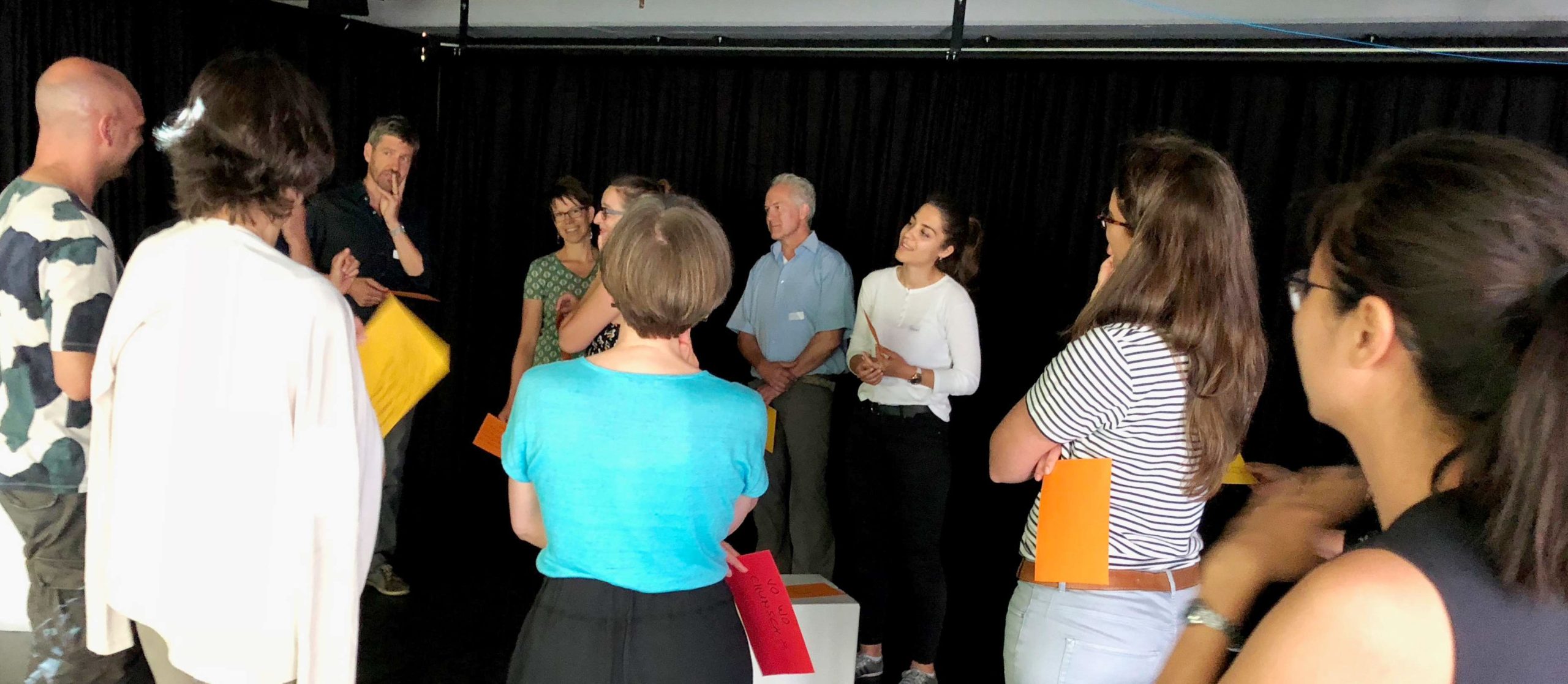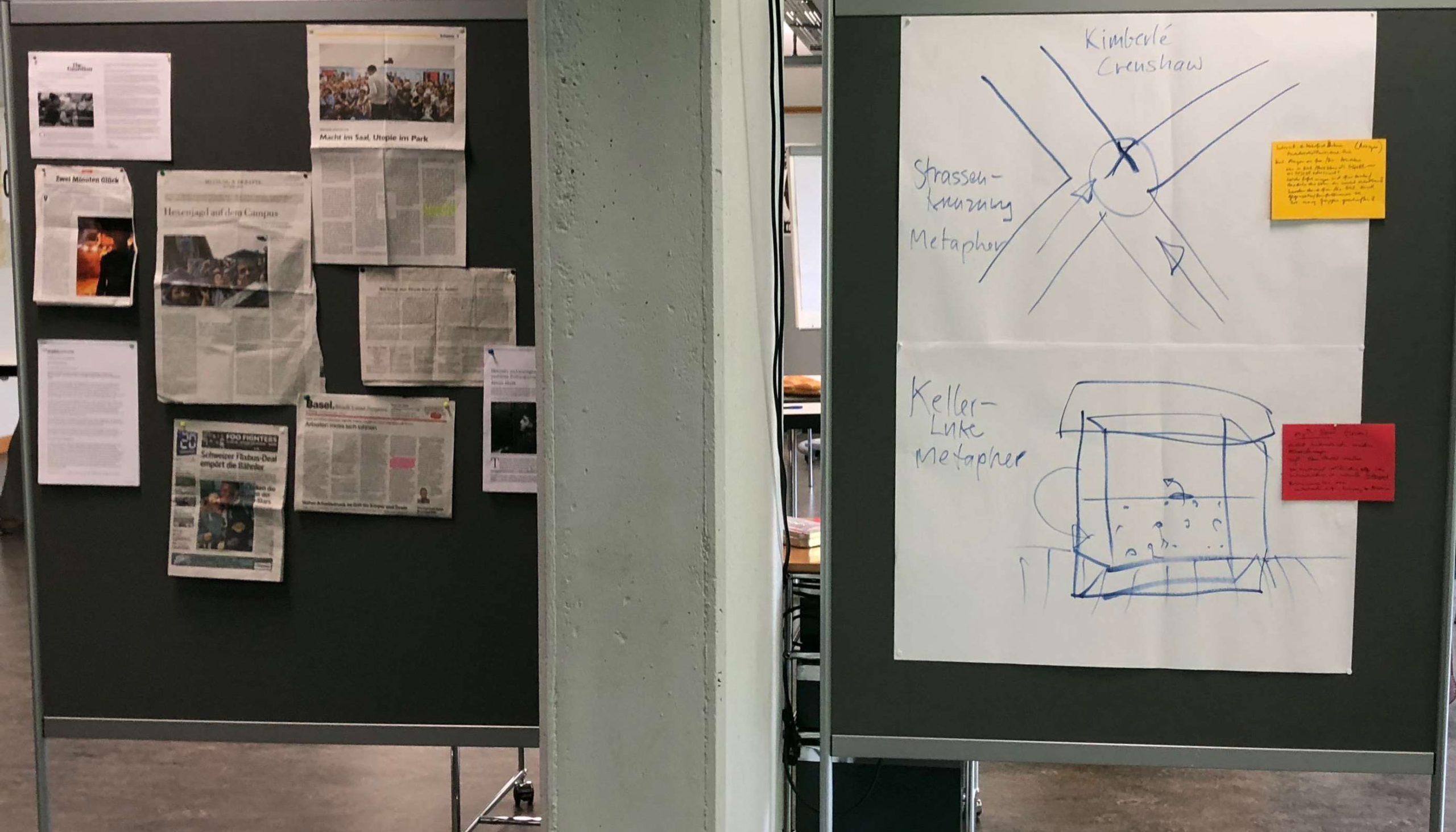Processes of racialization – deciphering through Boal’s newspaper theater (2018)
The atelier focused on aspects of the “newspaper theater” developed by Augusto Boal. In preparation of the atelier, the participants were asked to search for newspaper articles in which a thematic reference to diversity and variety or to exclusion, marginalization and discrimination are recognizable. They were also invited to mark a sentence in the article that seemed particularly telling and to bring the original or a printout of the article with them. In the introductory sequence, each person in the echo group had the opportunity to introduce themselves using as inspiration the article they had brought along or the sentence they had marked.
1st atelier sequence: Rhythmic reading
Setting: The sentences – written down on cards by the individual participants before getting to know each other – were spread out on the floor of the studio room.
When entering the studio room, the first task was to “tap” and “strip off” habitual roles (such as (diversity) experts and/or representatives of a university). Having “warmed up” in this way, all participants chose one of the sentences laid out in order to make it “sound” and “move” (inspired by instructions for actions of Boal). After this activity, in which the sentences were given new meanings and nuances through rhythmizing, the invitation to the participants was to link the sentences with each other to thus create chains. Finally, the participants formed “their” groups based on corresponding/similar sentences.

This experiment was concluded with an input reflection that tied the process of bringing persons into collectives and the process of organizing and categorizing different sentences/statements or topics regarding discrimination and marginalization.

The input focused on the “mythical norm” and the concept of intersectionality. Kimberlé Crenshaw – the author who coined and theorized as a first person this term – criticizes anti-discrimination policies that, from her perspective, are unable to grasp multiple discrimination and understand the underlying power relations at play (see video: Kimberlé Crenshaw: What is Intersectionality?). Who speaks and whose position in the social space becomes tangible and visible? These questions were reflected in the groups and brought into connection with the sentences, critically looking at whose voices were apparent and whose voice was unheard.
2nd atelier sequence: Coupled reading
Setting: White patches on the floor and boxes signifying stumbling blocks filled with reading material, books and QR codes provided possibilities of further type of knowledge acquisition; archives of literature and critical theoretical texts about diversity, postcolonialism and racism. At two mini standing desks, newspaper articles were stacked; further texts were attached to clotheslines crisscrossing the room.

According to Augusto Boal, coupled reading involves associatively relating different newspaper texts (text types) to each other so that new ways of reading become conceivable and possible through their juxtaposition. For the translated use in our atelier, two sets of newspaper articles and supplementary media and theoretical texts were made available for the participants to work on individually and collectively.
- A starting text marked in yellow: From the “lecture hall to the street” (student newspaper) led to demands and problematized everyday racism that students with a migration background face when they enroll in higher education. The initial questions were: What exclusions take place? What does the university do to prevent us from seeing that others are there too?
- An initial text marked in blue “What do you have against my headscarf?” (Zeit Online) led to further texts by researchers of color that deal with white privilege, highlighting racism in academic disciplines. The initial question here was: How does academic knowledge constitute itself and what knowledge do we know?
Initially individually, and increasingly in smaller groups, the participants worked with the texts and selected particularly meaningful sentences in order to put them together in new and different ways with the aim of constellating new insights. The small groups then presented their thought processes in differing ways (performative, theatrical, explanatory, etc.). In dealing with the exclusions and “whiteness” of science and academia, it became clear that gaps (non-knowledge) and white spots arise as “other” forms of knowledge and perspectives critical of discrimination are hardly included in the academic canon. Through this reflection it became obvious why non-privileged people find it institutionally and structurally difficult to access higher education and evolve in there.
The contextualizing summary of this sequence opened up a view of the common movement of the two strands in space: while the “some” experience high hurdles when entering higher education, the “others” are confronted with an almost exclusively white knowledge within the higher education space. This transitional conclusion to the sequence was brought to a close by a performative reading of points from the “List of White Privileges” (see Ogettes, Tupoka (2018): Exit Racism: learning to think critically about racism).
3rd sequence: Transfer to everyday university life
What do I want to and can I do in my own practice/teaching and work as an equal opportunities officer and/or lecturer at the university?
The attention gained from the workshop sequences that the participants considered important in their future areas of activity at the university were recorded on cards. The cards were then arranged in a sculptural form which highlighted the intricacies and interrelatedness of the meaning to become active – this was briefly discussed in the conclusion of the atelier.
